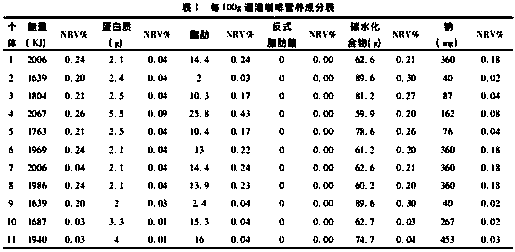Method of preparing fermented coffee by using intestinal bacteria of cats
A technology of intestinal bacteria and intestinal flora, which is applied in the treatment of roasted coffee, biochemical equipment and methods, microorganisms, etc., can solve the problems of high price, low caffeine concentration, and difficulty in the production of cat feces coffee. Low, pleasant mood, weak bitterness effect
- Summary
- Abstract
- Description
- Claims
- Application Information
AI Technical Summary
Problems solved by technology
Method used
Image
Examples
specific Embodiment 1
[0044] Specific Example 1: (1) Isolation and purification of the intestinal flora of civet cats: 10 g of feces and 100 mL of sterile water were put into a homogenization bag, beat for 5 minutes with a homogenizer, centrifuged in a high-speed refrigerated centrifuge, and removed the supernatant , to make a homogenate; identification: first prepare the identification medium of enteropathogenic bacteria (peptone 17.2g, tryptophan 0.9g, Hepes buffer 0.4g, mixed color source 6.87g, agar 18g, purified water 1L, pH 7.3 ) to identify whether there are pathogenic bacteria in the intestinal flora, if there are no pathogenic bacteria, the following experiments are carried out; preparation medium: prepare beef extract peptone medium, Sabouraud dextrose peptone agar, yeast enrichment medium , Eosin methylene blue lactose medium, and Hektoen medium, about 500mL each, aliquoted, sterilized at 121°C for 15 minutes; pour plate: beef extract peptone medium, Sabouraud dextrose peptone agar, yeast...
specific Embodiment 2
[0045] Specific Example 2: (1) Isolation and purification of the intestinal flora of civet cats: 10 g of feces and 100 mL of sterile water were put into a homogenate bag, beat for 5 minutes with a homogenizer, centrifuged in a high-speed refrigerated centrifuge, and removed the supernatant , to make a homogenate; identification: first prepare the identification medium of enteropathogenic bacteria (peptone 17.2g, tryptophan 0.9g, Hepes buffer 0.4g, mixed color source 6.87g, agar 18g, purified water 1L, pH 7.3 ) to identify whether there are pathogenic bacteria in the intestinal flora, if there are no pathogenic bacteria, the following experiments are carried out; preparation medium: prepare beef extract peptone medium, Sabouraud dextrose peptone agar, yeast enrichment medium , Eosin methylene blue lactose medium, and Hektoen medium, about 500mL each, aliquoted, sterilized at 121°C for 15 minutes; pour plate: beef extract peptone medium, Sabouraud dextrose peptone agar, yeast enr...
specific Embodiment 3
[0046]Specific Example 3: (1) Isolation and purification of the intestinal flora of civet cats: 10 g of feces and 100 mL of sterile water were put into a homogenization bag, beat for 5 minutes with a homogenizer, centrifuged in a high-speed refrigerated centrifuge, and removed the supernatant , to make a homogenate; identification: first prepare the identification medium of enteropathogenic bacteria (peptone 17.2g, tryptophan 0.9g, Hepes buffer 0.4g, mixed color source 6.87g, agar 18g, purified water 1L, pH 7.3 ) to identify whether there are pathogenic bacteria in the intestinal flora, if there are no pathogenic bacteria, the following experiments are carried out; preparation medium: prepare beef extract peptone medium, Sabouraud dextrose peptone agar, yeast enrichment medium , Eosin methylene blue lactose medium, and Hektoen medium, about 500mL each, aliquoted, sterilized at 121°C for 15 minutes; pour plate: beef extract peptone medium, Sabouraud dextrose peptone agar, yeast ...
PUM
 Login to View More
Login to View More Abstract
Description
Claims
Application Information
 Login to View More
Login to View More - R&D
- Intellectual Property
- Life Sciences
- Materials
- Tech Scout
- Unparalleled Data Quality
- Higher Quality Content
- 60% Fewer Hallucinations
Browse by: Latest US Patents, China's latest patents, Technical Efficacy Thesaurus, Application Domain, Technology Topic, Popular Technical Reports.
© 2025 PatSnap. All rights reserved.Legal|Privacy policy|Modern Slavery Act Transparency Statement|Sitemap|About US| Contact US: help@patsnap.com

